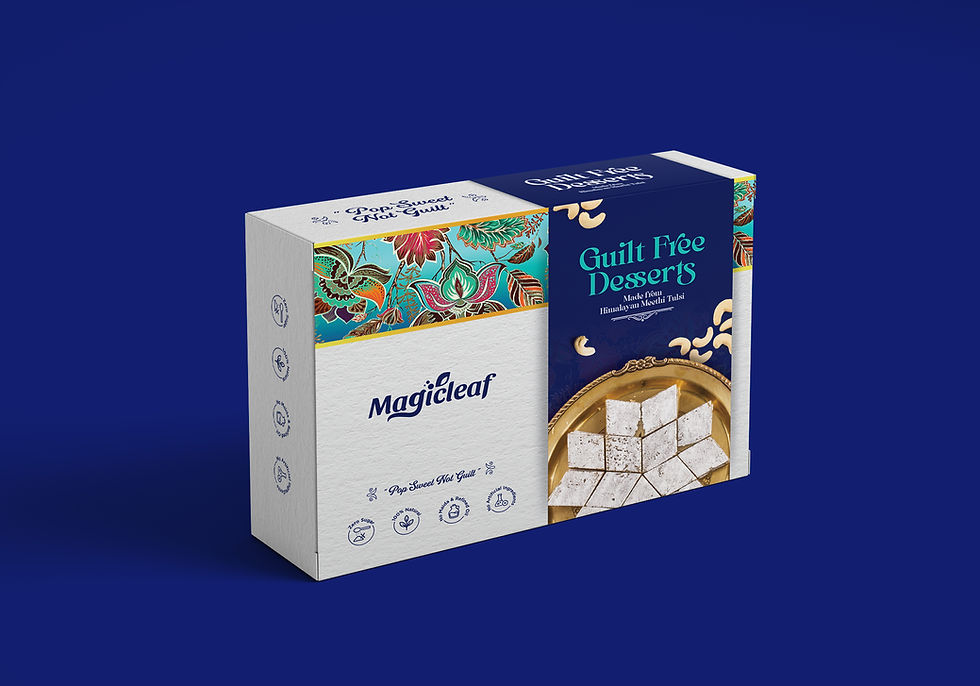Why Packaging Sells More Than You Think
- Brindha Dhandapani
- 13 hours ago
- 3 min read

We’ve all heard the phrase “don’t judge a book by its cover.” But let’s be honest when it comes to products, consumers do exactly that. Packaging is often the very first touchpoint between your brand and a potential buyer. It’s the silent salesperson that makes its pitch in seconds, without saying a word.
In fact, research shows that 72% of Americans say packaging design influences their purchase decisions when choosing between competing products on the shelf. That means your packaging could be the reason a customer picks you.
Branding vs. Marketing in Packaging
Branding and marketing often get used interchangeably, but in reality, they’re two sides of the same coin.
Branding is your long-term identity. It’s who you are, what you stand for, and how you want to be remembered. Strong branding communicates your personality, values, and positioning in a way that builds lasting recognition and trust.
Marketing, on the other hand, is more immediate. It’s the campaigns, visuals, and messages you use to promote your brand in the short term. It adapts to market shifts, trends, and consumer behavior.
Product packaging sits right at the intersection of these two. It carries your brand identity while also acting as a marketing tool that grabs attention, sparks emotions, and nudges buyers to act.
Branding Through Packaging
1. Establish a Unique Brand Identity
Packaging is one of the most visible expressions of your brand. From your logo and color palette to your typography, these elements create a visual language that customers learn to recognize. When done consistently, this visual cohesion helps your product stand out even in crowded spaces.
Think about Coca-Cola. You don’t need to read the label to know what it is, the iconic red background and white script do the talking. That’s the power of consistent packaging design.
2. Reflect Brand Positioning
Packaging is also a subtle cue for how your product should be perceived. Luxury brands, for instance, often use embossing, metallic foils, and heavy textures to signal exclusivity. Affordable, everyday brands tend to keep things approachable with simple shapes, bright colors, and transparent labeling.
3. Build Loyalty Through Authenticity
Today’s consumers value transparency. Packaging that clearly communicates ingredients, origins, and usage builds trust. But authenticity isn’t only about the information you print, it’s also in the design choices you make.
For example, brands using biodegradable packaging or kraft paper aren’t just protecting their products; they’re sending a signal about their values. When packaging reinforces what your brand stands for, it helps you earn long-term loyalty.
Packaging as a Marketing Tool
Create Shelf Impact
Walk into a supermarket and you’re instantly surrounded by thousands of products shouting for attention. The ones you notice first? They’ve nailed their packaging.
Bold colors, unusual shapes, clever cutouts, or even minimalist silence can all work if they align with the brand. The key is being distinct enough to spark curiosity while staying true to your identity. That “shelf impact” is often the first step toward a sale.
Spark Emotions
Marketing is emotional at its core, and packaging is no different. Many brands use vintage-inspired design to tap into nostalgia, which resonates especially well with younger consumers who crave “retro-cool” products. Others design packaging to celebrate cultural identity, helping communities feel represented and valued.
Storytelling is another powerful tool. A chocolate bar wrapped with illustrations of the farm where its cocoa was sourced, for instance, immediately feels more meaningful than a plain wrapper. When packaging tells a story, it makes customers feel part of something bigger than the product itself.
Elevate the Unboxing Experience
E-commerce has changed how we think about packaging. Today, opening a package is an event and one that people love to share online. Instagram is filled with “unboxing” videos, and one well-packaged delivery can generate more buzz than a paid ad campaign.
Research backs this up: 40% of consumers say they are more likely to share photos of packaging if it’s interesting or unique. That’s free, organic marketing created simply by investing in design.
Packaging and Sales: The ROI You Can’t Ignore
Still wondering whether packaging really impacts your bottom line? Here’s the proof: 32% of businesses experienced increased revenue after improving their packaging.
Why? Because packaging doesn’t just make a product look attractive, it influences trust, communicates quality, and makes customers proud to share and recommend it. In short, great packaging is more than cost, it’s an investment with measurable returns.
Final Thoughts
Packaging isn’t just about keeping a product safe. It’s about telling your story, signaling your value, and creating an emotional connection before the customer even takes the first bite, sip, or swipe. It is the silent salesperson standing in every store aisle, every online thumbnail, and every doorstep delivery.
Invest in packaging that reflects your brand identity, connects emotionally, and excites your customers, and you’ll see the payoff not just in sales, but in loyalty, advocacy, and long-term brand strength.




Comments